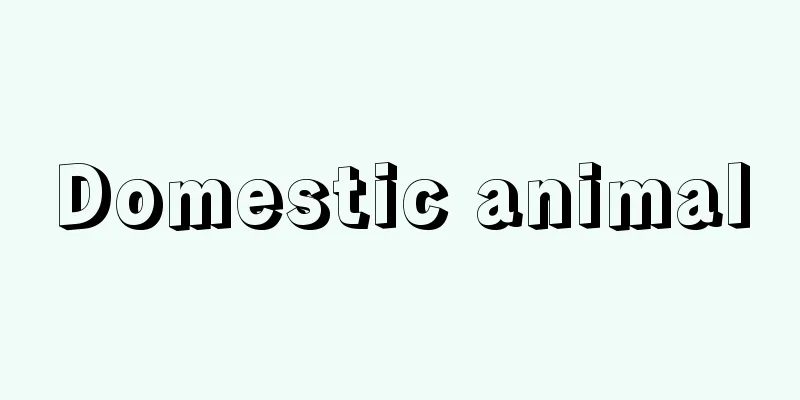Domestic animal

|
Refers to animals that have been genetically modified from wild animals for the purpose of use in human life. Depending on the purpose of use, they can be broadly divided into three types: farm animals, pet animals, and laboratory animals. In a broad sense, livestock includes these three types, but in a narrow sense it can refer only to farm animals that are directly involved in agricultural production. Farm animals are broadly divided into livestock that produce livestock products such as milk, meat, eggs, fur, leather, and feathers, and draft animals that provide labor. [Yoichi Shoda and Tomoko Nishida] Main livestock speciesCurrently, the main animals that are treated as livestock are as follows: (1) Mammals: Cattle, Bali cattle, gayal, yaks, water buffaloes, sheep, goats, Bactrian camels, dromedaries, alpacas, llamas, reindeer, pigs, horses, donkeys, dogs, cats, rabbits, mice, rats, guinea pigs, hamsters, minks, and ferrets. (2) Birds: Chickens, turkeys, guinea fowl, quails, ducks, Muscovy ducks, geese, pigeons, and canaries. (3) Fish: Carp, goldfish, and guppies. (4) Insects: Silkworms and honeybees. Indian elephants used in Southeast Asia and cormorants used in cormorant fishing are sometimes called livestock, but since they are not bred under human control and are not genetically different from wild animals, they do not fall into the category of livestock. In general, in Japan, the term refers only to mammals and birds, excluding fish and insects. Also, birds are sometimes called poultry, and only mammals are called livestock in the narrow sense. [Yoichi Shoda and Tomoko Nishida] The beginning of domesticationIt is believed that humans began domesticating animals around 20,000 years ago, during the Neolithic period. In addition to economic reasons for domesticating animals, such as ensuring a stable food supply, there are also thought to have been religious reasons for domesticating animals, such as offering them as "sacrifices" to the gods, and the significance of their existence as pets. There were also factors on the animal side that made them susceptible to domestication. Dogs and pigs were naturally scavengers in the wild, but as they came into close contact with humans and developed a symbiotic relationship, they were domesticated. Cattle and sheep live in groups and have a strong tendency to follow leaders within the group, so the whole group was brought under human management. This type of domestication is thought to have taken place 20,000 to 10,000 years ago for dogs, about 10,000 years ago for sheep, goats, cattle, and pigs, 5,000 years ago for horses, and 4,000 years ago for chickens. Each domestic animal has a wild animal as its ancestor, but the ancestor may be a single species or multiple species. Even in animals that are thought to have a single ancestor, genes from other closely related species may have been introduced after the animal was domesticated. The main ancestors of domestic animals are as follows (underlined species are extinct): Cattle ( Aurochs ), horses (Przewalski's horse, Tarpan , Eastern Tarpan ), sheep (Mouflon, Urial, Argali), goats (Bezoar goat, Markhor goat), pigs (Wild boar), rabbits (Hare), chickens (Red jungle fowl), ducks (Mallard), geese (Greylag goose, Swan goose), and turkeys (Wild turkey). Being under the care and management of humans, livestock are able to avoid the pressure of natural selection that wild animals faced, and instead are subjected to artificial selection for human captivity purposes. As a result, various morphological and physiological changes are observed. Morphological changes include irregular coat color patterns (cattle, horses, pigs, goats), curled tails caused by muscle force rather than bone bending (pigs and dogs), drooping ears with large drooping earlobes (cattle, goats, pigs, dogs, rabbits), and curved faces caused by shortening of the lower jaw bone (horses, sheep, pigs, dogs). Physiological changes include, first of all, increased reproductive ability. In general, animals reach sexual maturity at an earlier age in captivity, and seasonally breeding animals have a wider range of breeding seasons, and in extreme cases, they become year-round breeders (cattle, pigs). Also, the number of offspring produced by multiparous animals increases. Secondly, there is a degeneration of the instinctive sense of self-defense. In terms of disease resistance and adaptability to the environment, in-breeding is practiced in improved breeds to fix the genetic makeup, so they are generally inferior. In addition, there is greater variation within a species in domesticated animals than in wild ones. This is because, while natural selection works to maintain species constancy in wild animals, artificial selection works in different directions in domesticated animals depending on the purpose of improvement. For example, even though they are both domestic dogs, the weight difference between a St. Bernard and a Chihuahua is 100 times that of each other, which is greater than the variation in the entire Canidae family, including wild species. [Yoichi Shoda and Tomoko Nishida] breedingLivestock have been improved over a long period of time for the purpose of breeding, and their productivity has improved remarkably. Mammals normally only produce enough milk to raise their own young, but dairy cows have been bred to produce 10,000 to 20,000 kilograms of milk per year. Jungle fowls only lay a dozen or so eggs per year, but egg-laying chickens can lay 365 eggs per year. To genetically improve productivity in this way, it is necessary to select individuals with excellent genetic qualities and use them for breeding as breeding stock. Excellent breeding stock must have high productivity, a good body type that allows them to fully utilize that ability, and be able to reliably pass on these qualities to their offspring. For this purpose, various tests are carried out for each livestock, such as ability tests to check production ability (lactation ability tests, egg-laying ability tests, etc.), offspring tests to check reproduction ability, appearance tests to check body shape, progeny tests to check the reliability of heredity, pedigree registration, etc. In recent years, in livestock species such as pigs and chickens, where the practical livestock used for production and the breeding livestock are clearly distinguished, it is extremely advantageous to utilize heterosis (the difference between the average of the first generation of hybrids and the average of both parents) in the practical livestock, so three-way and four-way crosses (crosses involving three or four lines) are systematically carried out, and the creation of inbred lines and the selection of compatible lines are actively carried out for this purpose. Meanwhile, research and development has progressed into cloning technology, which applies genetic engineering techniques to create copies of parents from somatic cells as a means of producing higher-quality livestock. In 1996, Britain succeeded in producing a cloned sheep, but as of 2002, it has not yet been put to practical use. [Yoichi Shoda and Tomoko Nishida] BreedingIn order to increase the number of livestock, in extensive farming methods, male and female animals are sometimes kept together in a herd and mating is allowed to occur naturally, but in order to increase the efficiency of breeding and improve the effectiveness of breeding, it is necessary to artificially control reproduction. Cattle and pigs can breed all year round, but seasonal breeding animals such as horses are in the spring and sheep and goats in the fall. During this season, female livestock go into heat periodically and only tolerate male livestock during this period, so they are mated at the appropriate time by observing the signs. In recent years, artificial insemination technology has become widespread, making it unnecessary to transport livestock for mating. In addition, it has become possible to freeze semen and store it semi-permanently, making it possible to make effective use of a small number of excellent male livestock. Recently, a technology has been developed in which excellent female livestock are artificially inseminated by superovulating them through hormone treatment, and then the collected fertilized eggs are transplanted into other cows whose estrus cycles have been synchronized in advance for artificial insemination, making effective use of excellent female livestock. Furthermore, this technology can artificially induce twins in single cows, making it extremely effective for reproduction. In addition, research and development of cloning technology has progressed, and in addition to the conventional method of dividing fertilized eggs and transferring nuclear material, it has been successful in producing them from adult somatic cells. In 1996, a cloned sheep was created using somatic cells in the UK, and in 1998, a cloned cow was created in Japan. This could make it possible in the future to mass-produce high-quality livestock without the need for male animals. In addition, early pregnancy diagnosis methods are widely used to diagnose whether female livestock are pregnant at an early stage and improve the efficiency of reproduction. Furthermore, since keeping the calf with its mother and nursing it for a long time after giving birth places an excessive burden on the mother and delays the next breeding, techniques such as early weaning and raising it on artificial milk are also being implemented for meat livestock. [Yoichi Shoda and Tomoko Nishida] Breeding and ManagementJust like humans, livestock require the nutrients of protein, fat, carbohydrates, minerals, and vitamins. To ensure that these nutrients are provided in the right amount and economically, feeding standards are set for each livestock. The amount of nutrients required as maintenance feed is determined from the weight of the livestock, and the amount of production feed appropriate to production (milk production, meat production, egg production, pregnancy, growth, labor, etc.) is added to that. The amount and mix ratio of feed to be given are then determined based on the nutrient content of the feed. For herbivorous animals such as cows and sheep, it is best to cover the maintenance feed with roughage such as grass and forage crops, and supplement the production feed with concentrated feed. For omnivorous animals such as pigs and chickens, concentrated feed is the main source of feed, but it is better to mix as many different ingredients as possible to avoid nutritional imbalance. For herbivorous livestock, grazing on pastures is good for the health of the livestock and reduces the labor required for management. However, to protect livestock from the harsh outside environment and to facilitate production and hygiene management, it is necessary to build livestock barns and keep them in these buildings. For livestock that are not so closely tied to the land, such as pigs and chickens, a system is used in which a large number of individuals are kept intensively and engaged in production. Examples of this are the cage and battery system used for laying hens and broilers. In such cases, livestock waste and wastewater from the barns can become a source of pollution, so wastewater treatment facilities are required. To maintain the health of livestock, it is also important not to neglect brushing the skin and trimming the hooves of the legs. Male livestock raised for fattening meat must be castrated at a young age, and sheep raised for down have their tails docked shortly after birth. For horned livestock, it is advisable to dehorn them to prevent accidents when raising them in groups. For chickens, beaks are usually trimmed to prevent rearing pecking and to avoid wasting feed. [Yoichi Shoda and Tomoko Nishida] HygieneLivestock diseases include various infectious diseases as well as parasitic diseases, nutritional disorders, reproductive disorders, poisonings, tumors, and surgical diseases such as bone fractures. Of these, the most important infectious diseases are designated as legally notifiable diseases, and owners of infected livestock must immediately report them to the mayor of their city, town, or village. As livestock are economic animals, it is natural that emphasis should be placed on disease prevention. Furthermore, there are many diseases that have a significant impact on productivity even if they are not life-threatening, and how to prevent these is extremely important in livestock management. [Yoichi Shoda and Tomoko Nishida] Major livestock and human historyDogs and catsThe first animal that humans domesticated was the dog. There are undoubted examples of domestic dogs from Mesolithic ruins in Europe and Western Asia dating back about 10,000 to 12,000 years ago. Bones of similarly old domestic dogs have also been excavated in the Midwestern United States. They are thought to be the descendants of wolves that originated in Eurasia. It is still unclear whether dogs were domesticated in Central Europe or Western Asia and then spread to other areas, or whether they developed in a multi-sourced way, but in any case, it is certain that they were domesticated by hunter-gatherers. Wolves, the ancestors of dogs, are hunting animals that have the ability to skillfully control the retreating behavior of the animals they are hunting, isolating and preying on several of them. These abilities, along with their tendency to become more easily tamed than other animals, suggest that they were already playing the role of hunting dogs in the Mesolithic period. In addition, their keen sense of smell, aggressiveness, and loyalty, which have been cultivated during the process of domestication, have led to their use as guard dogs since ancient times. After the establishment of pastoral culture, these abilities were used to manage nomadic livestock, as in sheepdogs. However, when they were first domesticated, it is believed that their habit of coming near human settlements to scavenge for leftover food and waste attracted attention, and it is also said that they were first used as livestock for meat. The custom of eating dog meat is still seen today in areas including Southeast Asia, East Asia, and the South Pacific, as well as in West and Central Africa. In China, a special breed of dog called the Chow Chow was created for meat, and in the Philippines, the tail is highly valued as a source of energy. On the other hand, there are also many areas where dog meat is avoided and can only be eaten under special conditions such as famine. This is influenced by religion, but also by the strong spiritual bond between dogs and humans, as dogs are sometimes kept as faithful servants and indoors. Dogs have been deeply involved in human society up to the present day as pets (including those used for other purposes), in addition to the uses already mentioned and as labor dogs such as Eskimo sled dogs. This has also led to the differentiation of a wide variety of breeds. Like dogs, cats are also a typical pet. However, compared to dogs, cats have a shorter history of domestication. Cats are difficult to control artificially in their reproduction, and they still retain the most wild characteristics. Domestication is thought to have begun in ancient Egypt, with the African wildcat as their ancestor, and during the Kingdom era, they were commonly kept as completely ordinary livestock. The motivation for domestication is said to have been to eliminate rats in grain stores, but they have also taken on religious significance since early times as objects of idol worship and totems. They are sacred animals to the goddess Bastet, who has a cat's head, and pet cats were buried with great care, and sometimes cat mummies were made. Even today in Egypt, cats are believed to bring good luck. By the way, dogs were also objects of worship in ancient Egypt. The jackal, which is said to be the ancestor of dogs, was believed to take human spirits into its body because it scavenged human carcasses, and was identified with the god Anubis, king of the underworld. In ancient Persia, dogs, along with chickens, were also thought to drive away evil spirits, and Cerberus in Greek mythology was a three-headed guard dog of the underworld. Even today, in European folk beliefs, it is said that dogs bark at night because they can see the spirits of the dead approaching. On the other hand, there are also beliefs that dogs are the ancestors of races. Myths about the ancestors of dogs are distributed throughout the vast areas inhabited by southern China, Southeast Asia, inland Asia, and the Eskimos and Inuit of Northeast Asia, North America, and Athabascan groups. A typical example is the Panhu myth of the Yao mountain people of southern China and Southeast Asia. In ancient China, dogs were used as sacrifices in religious rites, and similar customs existed in ancient India and Peru. It is not clear whether such religious importance was the initial motivation for domestication, but it is certain that it was at least a factor that accelerated the domestication process. [Tamura Katsumi] Reindeer, goats and sheepDomestic animals such as dogs and cats, which are kept in one or several homes, are called domestic livestock. On the other hand, livestock that are kept collectively, taking advantage of their inherent nomadic and gregarious ecology, are called nomadic livestock. The latter are herbivorous ungulates such as cattle, sheep, goats, horses, and reindeer, and their domestication had a great significance for human society. In other words, the livestock industry was established, and the nomadic lifestyle of humans, in which human settlements moved in accordance with the nomadic ecology of livestock, was born. The opportunity for the domestication of ungulates can be attributed to the drying of Western Asia about 10,000 years ago, which caused humans and animals to live close to water sources. Another important factor is the disruption of the balance between population growth and animal proliferation. Conversely, if there are many animals to hunt, it becomes difficult to domesticate them. Herbivores that are abundant in the savannah region of Africa have never been domesticated. In recent years, attempts have been made to domesticate elands and other animals due to food crises. The agricultural origin hypothesis of the domestication of ungulates is suggested by archaeological evidence and the fact that nomads maintained an exchange economy with agricultural people, but on the other hand, the hunting origin hypothesis is also advocated, which says that it developed from a symbiotic relationship between hunter-gatherers and herds of herbivores. In other words, in exchange for some herbivores being hunted by humans, humans provided protection from carnivores. The selective hunting of males by hunter-gatherers led to the technique of artificial culling of livestock, which involves slaughtering or castrating males, and it is also quite conceivable that hunter-gatherers captured live young animals and kept them. By the way, there was once a theory that domestication began with reindeer, which live in northern Eurasia. The idea was that reindeer, which approached humans seeking protection and the salts contained in human urine, became domesticated as a group through a symbiotic relationship with hunter-gatherers, and horses and other animals were domesticated in the same way. This theory is now refuted by archaeological evidence, and it is believed that reindeer herding, as well as techniques such as milking and riding, are due to the influence of Central Asian nomads. However, reindeer are important as working animals for pulling sleds, carrying loads, and riding, and their meat, bones, and skins have also been widely used among the Siberian peoples and the Finns and Sami peoples of northern Europe. There was little human interference in their reproduction, and they often crossed with wild species. Therefore, the influence of domestication on their characteristics is small, and no differentiation of breeds is observed. In this respect, reindeer can be said to be in a semi-domesticated state. The oldest evidence of the domestication of ungulates is the bones of goats (or sheep) excavated from early Neolithic ruins in Western Asia. It is not clear whether they were domesticated by hunters or farmers, but one theory is that domestication began with the capture of wild goats that invaded agricultural land where grasses were grown. Goats have a penchant for eating grass, leaves, and young shoots, and it is said that they were kept in the early days of established agriculture to help with land reclamation. In any case, domesticated goats were widely distributed from Western Asia to the east and west. This is because goats have the ability to adapt to a variety of environments and can withstand rough husbandry so that they can easily re-go wild. In addition to meat, which is thought to be the initial use for domestication, they are also useful for milk, skin, and wool. The cashmere and angora breeds that are distributed in the arid regions of Central and Western Asia are typical goats for wool. Like goats, sheep have been domesticated since ancient times, and in the early days, meat and fat were valued, but with the development of a technology for making felt from wool in Central Asia, sheep's value for wool increased. Later, they were linked to the wool industry in Europe, and contributed greatly to the modernization and industrial revolution of Britain. Sheep and goats are raised in the mountainous areas of southern Europe, and are nomadic with other livestock among pastoralists from Central Asia to Africa. Goats are also kept as household livestock by agriculturalists in various regions, and are used for their meat and, in some cases, their milk. However, goats are generally less valued than cattle, and for example, among cattle nomads in East Africa, they are slaughtered relatively easily, and are considered to be of less value even when used as sacrifices or bride prices. In the Assyrian period in ancient Mesopotamia, goats had a sacred significance and were sacrificed to the gods. Goats are often mentioned in the Old Testament, and are described as sacrificial animals to the gods along with sheep and cattle. [Tamura Katsumi] Cows and pigsThe two livestock that have played a major role in the economic history of mankind are probably cattle and pigs. Both were domesticated 7,000 to 8,000 years ago, slightly later than goats. Both are thought to have been domesticated by settled agriculturalists, but while the center of domestication of cattle is assumed to be the northeastern Mediterranean region, such as Anatolia, the center of domestication of pigs is unclear. Some believe that the origin of pigs lies in Southeast Asia, where pigs are still allowed to roam freely and are seen to crossbreed with wild boars, but there is also a strong view that they were domesticated in various places. The theory of pig domestication is based on the nature of pigs, which are slow to move and not suitable for moving. For this reason, pigs were not adopted as livestock by nomads, but were kept by settled agriculturalists as a food source for meat and fat, taking advantage of their tendency to become tame and gain weight easily, their omnivorous nature, and their high productivity. Pigs in the South Pacific islands were brought by the proto-Malays around 2000 BC, and are of great value due to the absence of other large livestock. In Melanesia, pork is used for sacrifices, functions as currency, and is used for bride prices. In China, pork is the most valuable meat, and is used in ceremonies as one of the three sacrifices, and in parts of Southeast Asia, there are myths that pigs are the ancestors of certain tribes. In the Middle East, pigs were also kept as sacrificial animals for gods in ancient times. Later, the idea of aversion to pigs spread mainly in this region, and even today, Muslims and Jews do not eat pigs, considering them unclean. Herodotus states that in ancient Egypt, pigs were considered unclean animals, kept only by certain groups, and sacrificed only to the god Osiris. It is said that the view of pigs as unclean is rooted in the feelings of nomads who despise the lifestyle of settled agriculturalists and dislike pigs, which are unsuitable for mobility, as a symbol of this. In Europe, pork has never been avoided, but it has often been the subject of loathing and contempt, as seen in the Middle Ages when the popular belief was that the devil was fond of eating pork and would transform into a sow. Compared to the low status of pigs, cows have an extremely high status. Hindus' aversion to cow meat stems from their belief in the sanctity of cows. Cows have been widely worshipped since ancient times, and are considered sacred animals of gods associated with agriculture, such as Ishtar (Babylonia), Isis (ancient Egypt), Demeter (ancient Greece), Ceres (ancient Rome), and Shiva (India). In China, Shennong, an agricultural god with a human body and a cow's head, is also known. The importance of cows can also be seen in the world of mythology, such as the idea of cows supporting the earth, which is widespread mainly in Islamic countries. The theory that cow breeding originated as a sacrifice to the moon god has now been rejected, but cow sacrifices were performed in the ancient Orient, in India during the Vedic period, and in China during the Yin dynasty, and were often linked to the idea of fertility. Even today, the custom of sacrificing cattle or water buffaloes exists among the agricultural peoples of Southeast Asia, and one of its important functions is the magical promotion of wealth and fertility. The importance of cattle as described above is due to their high usefulness. In addition to using meat, milk, and hides, cattle became established among agricultural people as valuable working animals when combined with the plow, which was invented in Western Asia around 5000 to 4000 BC. Furthermore, the invention of the wheel made it possible to transport large amounts of goods over long distances by using cattle for traction. Cattle are also important livestock for pastoralists. Milking was first done with goats, but it was also applied to cattle, and various dairy production techniques were developed. The cattle nomads of East Africa do not eat meat except when the cattle die naturally or are sacrificed, but they use milk and blood as food, dung as fuel and wall plaster, and urine to wash their faces, making cattle an essential resource for their lives. Therefore, cattle are used as compensation and bride price, and social status is determined by the number of cattle, which has important social significance as it establishes social relationships and causes conflicts. As in other pastoral societies, patrilineal kinship groups exist and male age structures are well developed, probably related to the fact that livestock management is primarily in male hands. Water buffaloes, found in southern Asia, were domesticated during the Indus civilization, and are used for pulling plows and riding, as well as for meat and milk. Bali cattle (Banteng) and yaks are distributed mainly in Indonesia and the Himalayan highlands, respectively, as beasts of burden. Bali cattle are used for meat and yaks for milk. Gayar (Mithan), kept semi-wild by mountain people from Assam to Burma (Myanmar), are used for ritual sacrifices. [Tamura Katsumi] Horses and CamelsCompared to cattle, horses are more labor-intensive to raise and require a large amount of nutritious feed. For this reason, they were not widely used as working animals among agricultural people, but they were respected as livestock by the ruling class because of their strength and speed. Donkeys, known as the "horse of the common people," were seen as livestock in Egypt around 3000 BC, and it is said that they were domesticated to carry loads. Around the same time, in Mesopotamia, the onager of the Equis genus was domesticated and used mainly to pull carts. Onagers were later replaced by horses and abandoned as livestock, but donkeys are still used as working animals for draughts, loads, and riding, and are sometimes used for meat and milk. They play an important role in daily life in northern China, Western Asia, and the Mediterranean region. Mules, which are born from the mating of male donkeys and female horses, are docile and strong, making them useful as working animals. になったんです。 English: The first thing you can do is to find the best one to do.になったんです。 English: The first thing you can do is to find the best one to do. Livestock races are also found in dogs, camels, reindeer, and livestock are also used in fighting sports, such as bullfighting, dogfighting and cockfighting. になったんです。 English: The first thing you can do is to find the best one to do. Although some meat can be eaten, it is not found to be used in religious terms. The llamas and alpacas in the Andes highlands of South America are said to have been domesticated by the camel family guanacos and viknia, respectively, respectively, and the former is mainly for use for litter and the latter for hair. Elephants are also sometimes used for war and are used for labor in Southeast Asia, but are usually captured and acclimated, so it is hard to call them domesticated. [Tamura Katsumi] Doves and chickensになったんです。 English: The first thing you can do is to find the best one to do. になったんです。 English: The first thing you can do is to find the best one to do. Geese, which also uses meat and eggs, were already kept during the old kingdom of Egypt and are said to be the oldest poultry. Feathers are also used for decoration and feathering. Ducks are also used for meat and eggs, but domestication seems to have been relatively new in various places. Gyohoro-horo-no-no-no-no-no-no-no-no-no-no-no-no-no-no-no-no-no-no-no-no-no-no-no-no-no-no-no-no-no-no-no-no-no-no-no-no-no-no-no-no-no-no-no-no-no-no-no-no-no-no-no-no-no-no-no-no-no-no-no-no-no-no-no-no-no-no-no-no-no-no-no-no-no-no-no-no-no-no-no-no-no-no-no-no-no-no-no-no-no-no-no-no-no-no-no-no-no-no-no-no-no-no-no-no-no-no-no-no-no-no-no-no-no-no-no-no-no-no-no-no-no-no-no-no-no-no-no-no-no-no-no-no-no-no-no-no-no-no-no-no-no-no-no-no-no-no-no-no-no-no-no-no-no-no-no-no-no-no-no-no-no-no-no-no-no-no-no-no-no-no-no-no-no-no-no-no-no-no-no-no-no-no-no-no-no-no-no-no-no-no-no-no-no-no-no-no-no-no-no-no-no-no-no-no-no-no-no-no-no-no-no-no-no-no- In addition, livestock originating from the American continent, there are other livestock (guinea pigs), which were kept for food and sacrifice among the people of the ancient Andean region. Rabbits were domesticated in Spain, but in addition to using their fur and fur, they are also kept as pets, just like guinea pigs. [Tamura Katsumi] "The Encyclopedia of Livestock Production" (1989, Yokendo)" ▽ "The Encyclopedia of Livestock Production Editorial Committee, "New Encyclopedia of Livestock Production" (1996, Yokendo)" ▽ "The Idemitsu Science Series 18: Livestock and Humans" (1981, Idemitsu Shoten)" ▽ "The History of Livestock Culture by Kamo Giichi (1973, Hosei University Press)" ▽ "The Road of Livestock Production" by H. Dembeck, translated by Konishi Masayasu et al. (1979, Tsukiji Shokan)" [Reference Item] | |Source: Shogakukan Encyclopedia Nipponica About Encyclopedia Nipponica Information | Legend |
|
人間の生活に利用する目的で、野生動物から遺伝的に改良した動物をいう。利用の目的によって農用動物farm animal、愛玩(あいがん)動物pet animal、実験動物laboratory animalの3種に大別することができる。また、広義の家畜はこの3種を含むが、狭義には農業生産に直接かかわっている農用動物のみを意味することもある。農用動物には乳、肉、卵、毛、皮革、羽毛などの畜産物を生産する用畜と、労働力を提供する役畜とに大別される。 [正田陽一・西田恂子] おもな家畜の種類現在、家畜として取り扱われているおもな動物は次のとおりである。 (1)哺乳(ほにゅう)類 ウシ、バリウシ、ガヤル、ヤク、スイギュウ、メンヨウ、ヤギ、フタコブラクダ、ヒトコブラクダ、アルパカ、ラマ、トナカイ、ブタ、ウマ、ロバ、イヌ、ネコ、ウサギ、マウス、ラット、モルモット、ハムスター、ミンク、フェレット。 (2)鳥類 ニワトリ、シチメンチョウ、ホロホロチョウ、ウズラ、アヒル、バリケン、ガチョウ、イエバト、カナリア。 (3)魚類 コイ、キンギョ、グッピー。 (4)昆虫類 カイコ、ミツバチ。 東南アジアで使役されているインドゾウや鵜飼(うかい)に使われるウミウを家畜とよぶ場合もあるが、これらは人間の管理下で繁殖していないし、野生のものと遺伝的に異なるものでもないので、家畜の範疇(はんちゅう)には入らない。一般に日本では魚類、昆虫類は除いて、哺乳類と鳥類に属するもののみをさす場合が多い。また、鳥類に属するものを家禽(かきん)として、哺乳類だけを狭義の家畜とよぶこともある。 [正田陽一・西田恂子] 家畜化の成立人間が家畜化に着手したのは約2万年前、新石器時代のこととされている。家畜化の動機としては食料の安定供給という経済的な目的のほかに、神への「いけにえ」にするという宗教的な目的や、愛玩動物としての存在意義などもあったと考えられる。 また、動物の側にも家畜化されやすい要因が存在した。イヌやブタは野生の生態での掃除屋scavengerとしての性格から、人間の生活へ接近して共生関係が発生し、家畜へと順化された。ウシやヒツジは群れ生活をし、集団のなかではボスに従う性質が強いので、群れごと人間の管理のもとに組み入れられることになった。このような家畜化はイヌで2万~1万年前、メンヨウ、ヤギ、ウシ、ブタで約1万年前、ウマで5000年前、ニワトリで4000年前に行われたとされている。 家畜はそれぞれ野生動物を祖先にもっているわけであるが、その祖先種は単一のものもあるし、複数のものもある。単一の祖先種をもつと考えられているものにも、家畜化されてから近縁の他種の遺伝子が導入されている場合もある。おもな家畜の祖先種は次のとおりである(下線は絶滅種)。 ウシ(オーロックス)、ウマ(モウコノウマ、タルパン、シンリンタルパン)、メンヨウ(ムフロン、ウリアル、アルガリ)、ヤギ(ベゾアールヤギ、マーコールヤギ)、ブタ(イノシシ)、ウサギ(アナウサギ)、ニワトリ(セキショクヤケイ)、アヒル(マガモ)、ガチョウ(ハイイロガン、サカツラガン)、シチメンチョウ(ヤセイシチメンチョウ)。 家畜は人間の飼育管理のもとにあることによって、野生動物のときに受けていた自然淘汰(とうた)の圧力を避けることができ、そのかわりに人間の飼育目的に向けての人為淘汰を加えられることになる。その結果、形態的にも生理的にもいろいろの変化が認められる。形態的変化としては毛色の不規則な斑紋(はんもん)(ウシ、ウマ、ブタ、ヤギ)、骨の曲がりでなく筋肉の力で巻いた巻き尾(ブタ、イヌ)、耳たぶが大きく垂下した垂れ耳(ウシ、ヤギ、ブタ、イヌ、ウサギ)、下顎(かがく)骨の短縮により湾曲した顔面(ウマ、メンヨウ、ブタ、イヌ)などがある。生理的変化としてはまず第一に繁殖力の増大がある。一般に動物は飼育下では性成熟に達する年齢が早くなり、そのうえ季節繁殖動物では繁殖期の幅が広くなって、極端な場合には周年繁殖動物に変わる(ウシ、ブタ)。また、多胎動物では産子数も増加する。第二に自己防衛に関する本能的な感覚の退化が認められる。疾病に対する抗病性や環境に対する適応性についても、改良の進んだ品種では遺伝的な固定を図るため近親交配が行われているので、一般的に劣る場合が多い。このほか、家畜では野生のものに比べ種内の変異が大きい。これは、野生動物では自然淘汰が種の恒常性を保つように働くのに対し、家畜では改良目的によって異なった方向へと人為淘汰が働くためである。たとえば同じ家畜のイヌでもセントバーナードとチワワでは体重が100倍も異なり、これは野生種を含むイヌ科全体の変異よりも大きくなっている。 [正田陽一・西田恂子] 育種家畜はその飼養目的に向けて長い間改良が積み重ねられ、その生産能力は目覚ましい向上をみせている。哺乳動物は普通、自分の子を育てるのに足りるだけの乳しか分泌しないものであるが、乳用牛では年間1万~2万キログラムもの牛乳を生産するものもつくられている。また、ヤケイは1年に十数個の産卵しかしないが、卵用種のニワトリでは年間365個の卵を産むものもある。このような生産能力の遺伝的改良のためには、優れた遺伝的資質を備えた個体を選抜し、これを種畜として繁殖に供用することが必要である。優れた種畜とは、高い生産能力をもち、その能力を十分に発揮できるりっぱな体型を備え、さらにそれらの資質を確実に子孫に遺伝するものでなければならない。 そのために、生産能力を調べる能力検定(泌乳能力検定、産卵能力検定など)や繁殖能力を調べる産子検定、体型の良否を審査判定する外貌(がいぼう)審査、遺伝の確実さを確かめるための後代検定、血統登録などの事業が、それぞれの家畜について行われている。また近年、ブタやニワトリのように、生産に携わる実用畜と繁殖用の種畜とがはっきり区別される家畜種では、実用畜にヘテローシス(雑種第一代の平均と両親の平均との差)を利用することがきわめて有利なので、三元交雑や四元交雑(3系統または4系統が関与する交雑)が組織的に行われており、そのための近交系の作出や、相性のよい系統の選抜なども積極的に実施されている。 一方、優良家畜の生産手段として、遺伝子操作技術を応用し、体細胞から親の複製をつくりだすクローン技術の研究・開発が進み、1996年にはイギリスでクローン羊の生産に成功したが、2002年現在、実用化には至っていない。 [正田陽一・西田恂子] 繁殖家畜を増殖させるのに、粗放な飼養形態では、群れのなかに雄畜も雌畜もいっしょに入れて交配を自然に任せることもあるが、効率のよい増殖を図り、かつ育種の効果を高めるためには、繁殖を人為的に管理する必要がある。 ウシやブタは周年繁殖が可能であるが、季節繁殖動物のウマは春、メンヨウ、ヤギは秋がその時季で、この季節には雌畜に周期的に発情が訪れ、この期間だけ雄畜を許容するので、その兆候をみて適期に交配する。近年は人工授精の技術が普及し、交配のために家畜を輸送する必要がなくなった。また、精液を凍結して半永久的に保存することが可能となったため、少数の優れた雄畜を有効に利用することもできるようになった。最近では、優れた雌畜にホルモン処理により過排卵をおこさせて人工授精をしたのち、回収した受精卵を、あらかじめ発情周期を同調させておいた他の雌牛に移植して人工受胎させ、優秀な雌畜の有効利用を図る技術も開発されている。さらにこの技術は、単胎のウシなどに双生子を人為的に産ませることもできるので、増殖にきわめて有効である。また、クローン技術の研究・開発が進み、従来の受精卵分割・核移植による方法とは別に、成体の体細胞からの生産に成功した。1996年、イギリスで体細胞を用いたクローン羊が、98年には日本でクローン牛がつくられた。これは将来的に、雄畜なしに優良な家畜の大量コピーを可能にするものといえる。 また、雌畜の妊否を早期に診断して、繁殖の効率を高める早期妊娠診断法も広く行われている。さらに分娩(ぶんべん)後、子畜を長く母親につけ哺乳させることは、母畜に過大の負担をかけ、次回の繁殖を遅らせることになるので、早期に離乳し人工乳で育成する技術なども、肉畜では実施されている。 [正田陽一・西田恂子] 飼養・管理家畜の必要とする栄養素は人間と同様、タンパク質、脂肪、炭水化物、無機物、ビタミン類である。これらの栄養素を過不足なく、経済的にむだのないように給与するために、飼養標準が各家畜ごとに定められている。家畜の体重から維持飼料として必要な養分量が決定され、それに生産(産乳、産肉、産卵、妊娠、発育、労働など)に見合う生産飼料の量を加える。そして飼料の養分含量から給与する飼料の量と配合割合を定めるのである。ウシやヒツジのような草食動物は牧草や飼料作物といった粗飼料で維持飼料の分をまかない、生産飼料の分を濃厚飼料で補ってやるとよい。ブタやニワトリのような雑食性の動物では濃厚飼料が主体となるが、なるべく多種類の材料を配合したほうが、栄養が偏らなくてよい。草食性の家畜では牧野への放牧を中心に飼育することが家畜の健康にもよく、管理の労力も省ける。しかし外界の不良な環境から家畜を守り、生産管理、衛生管理の作業の便を図るためには、畜舎を設けて舎飼(しゃが)いをする必要がある。ブタやニワトリのように土地との結び付きの弱い家畜では、多数の個体を集約的に舎飼いし、生産に従事させる方式がとられる。採卵鶏やブロイラーでのケージやバタリー方式がこれである。このような場合には家畜の排出物や畜舎の汚水が公害源となるおそれがあり、汚水処理の施設が必要となる。 また、家畜の健康管理のためには皮膚のブラシングや四肢の削蹄(さくてい)を怠ってはならない。肥育用の肉畜では雄は幼時に去勢する必要があり、産毛用のメンヨウでは生後まもなく断尾を行う。有角の家畜では群飼の際の事故防止のために除角(じょかく)をしたほうがよい。ニワトリでは尻(しり)つつきを防ぎ、かつ飼料のむだを防ぐために断嘴(だんし)が行われるのが普通である。 [正田陽一・西田恂子] 衛生家畜の病気には、各種の伝染病をはじめ寄生虫病、栄養障害、繁殖障害、中毒症、腫瘍(しゅよう)病、骨折などの外科的疾患などがある。このうち伝染病でもっとも重要なものは法定伝染病に指定されており、これらにかかった家畜の所有者は、ただちに市町村長に届け出なければならない。家畜は経済動物であるから、疾病の予防に重点を置くことは当然である。また、生命にかかわる病気でなくとも生産性に大きな影響を与える疾病は多くあり、これらをいかに防除するかが、畜産経営のうえで非常に重要である。 [正田陽一・西田恂子] おもな家畜と人間の歴史イヌとネコ人類が初めて家畜化した動物はイヌである。およそ1万年から1万2000年前ごろのヨーロッパや西アジア各地の中石器時代の遺跡に、確実な家イヌの出土例がみられる。またアメリカ合衆国中西部にも同じくらいに古い家イヌの骨が出土している。これは、ユーラシア大陸に由来するオオカミの子孫と考えられている。イヌの家畜化が、中央ヨーロッパや西アジアなどでおこり各地に伝播(でんぱ)していったのか、あるいは多元的に発生したのかは、いまなお明らかでないが、いずれにしても狩猟民が家畜化を行ったことは確かである。イヌの祖先種であるオオカミは、狩りをする動物として、狩る対象の動物群の退避行動を巧みにコントロールし、そのうちの数頭を孤立させ捕食する能力をもっている。こうした能力は、他の動物に比し、ヒトになれやすい性向とともに、中石器時代にすでに猟犬としての役割をもっていたことを推測させる。また嗅覚(きゅうかく)に代表される鋭い感覚能力や、攻撃力、家畜化の過程で培われてきた忠誠心などは、古い時代からの番犬としての用途をもたらした。牧畜文化の成立以後は、牧羊犬のように、遊牧家畜の管理にこれらの能力が利用されてきた。しかし家畜化の当初は、ヒトの居住地近くにきて食べ残しや廃棄物をあさる習性が注目されたと考えられ、また肉畜として最初の用途があったともいわれる。イヌの肉を食べる風習は今日なお、東南アジア、東アジアと南太平洋を含む地域や、西・中央アフリカにみられ、中国では特別の食用犬種チャウチャウが生み出され、フィリピンでは尾が活力の源として貴重視される。他方でイヌの肉が忌避され、飢餓などの特別な条件の下でしか食べられない地域も広くみられる。これには宗教の影響があると同時に、イヌがヒトの忠実な従者として、ときに家屋内で飼われるように、イヌとヒトとの精神的な結び付きの強さが関係している。イヌは、その用途としてはすでに述べたものや、エスキモーのそり犬のような労役用のほかに、愛玩(あいがん)の対象として(他の用途との兼用も含め)現代に至るまで人類社会に深くかかわってきた。このことはまた、多種多様な形態をもつ品種の分化を生み出した。 イヌと同じくペットとして代表的なのはネコである。しかしネコは、イヌに比して家畜化の歴史が浅い。ネコは、その繁殖に人為的なコントロールが及びにくく、いまなお野生的性格をもっとも多く保持している。家畜化の起源は、古代エジプトでリビアヤマネコを祖先種として行われたと思われ、王国時代にはまったく普通の家畜として一般に飼われていた。家畜化の動機は、穀物貯蔵庫のネズミ退治にあったとされるが、偶像崇拝の対象、トーテムの一つとしても、早くから宗教的意義を帯びてきた。ネコの首をもつバステト女神の神聖な動物であり、飼いネコは丁重に葬られ、ときにネコのミイラがつくられた。今日なおエジプトでは、ネコが幸運をもたらすものと信じられている。 ところで、古代エジプトではイヌも崇拝の対象であった。イヌの祖先種との説もあるジャッカルは、ヒトの屍肉(しにく)をあさることから、その精霊も体内に取り入れると信じられ、冥界(めいかい)の王アヌビス神と同一視された。古代ペルシアにおいても、イヌはニワトリとともに、悪霊を追い払うものと考えられ、ギリシア神話のケルベロスは三つの頭をもつ冥界の番犬である。今日もヨーロッパの民間信仰では、夜にイヌがほえるのは死者の霊の近づいてくるのが見えるからといわれる。他方で、イヌを種族の始祖とする信仰もみられる。中国南部から東南アジア、内陸アジア、さらに東北アジアから北アメリカのエスキモーおよびイヌイット、そしてアサバスカン系の諸集団が住む広大な地域に、犬祖(けんそ)神話が分布する。代表的なのは、中国南部や東南アジアの山地民ヤオの槃瓠(ばんこ)神話である。また中国では古くからイヌが祭祀(さいし)の犠牲(いけにえ)とされ、古代インドや古代ペルーでも同様の風習があった。以上のような信仰上の重要性が家畜化の最初の動機であったかは明らかでないが、それが少なくとも家畜化の過程を促す要因であったことは確かである。 [田村克己] トナカイとヤギ・ヒツジイヌやネコなどのように、各家で1頭ないし数頭飼われる家畜は、家養家畜といわれる。他方で、本来の遊牧的・群居的生態を利用して集団的に飼われる家畜は、遊牧家畜と称される。後者は、ウシ、ヒツジ、ヤギ、ウマ、トナカイなどの草食の有蹄(ゆうてい)類であり、これらの家畜化は人類社会にとり大きな意味をもった。すなわち、牧畜という生業が成立するとともに、家畜の遊牧的生態にあわせてヒトの居住地も移動するという遊牧民の生活様式が生み出された。有蹄類の家畜化の機縁として、約1万年前の西アジアの乾燥化のために、ヒトと動物が水場近くに接近して生活するようになったことが指摘できる。また人口増加と動物増殖とのバランスが崩れたことも重要な要因とされる。逆に、狩猟の対象となる動物がたくさんいると家畜化されにくいことになる。アフリカのサバンナ地帯に豊富に生息する草食獣は家畜化されることがなかった。近年になって食糧危機からイランドなどの家畜化が試みられている。有蹄類の家畜化について、考古学的証拠や、遊牧民が農耕民との交換経済を維持していることなどから、農耕起源説がいわれるが、他方で、狩猟民と草食獣の群れとの共生関係から発展したとする狩猟起源説も唱えられる。すなわち、草食獣の一部がヒトに狩猟されるかわりに、肉食獣からの保護をヒトによって与えられるという関係である。狩猟民が雄を選別狩猟することは、雄のと畜や去勢という家畜の人為淘汰(とうた)の技術につながるものであり、また狩猟民が動物の子を生け捕りにして飼ったことも十分に考えられる可能性である。 ところで、家畜化の始まりを北方ユーラシアに生息するトナカイに求める説が、かつて唱えられた。人尿中に含まれる塩分や保護を求めて近づくトナカイが、狩猟民との共生関係を経て、群れごと家畜化され、これに倣ってウマや他の動物が家畜化されたとの考えである。現在この説は考古学的証拠などから否定されており、トナカイ遊牧は、搾乳や騎乗などの技術と同様に、中央アジアの遊牧民の影響によるものとされる。しかしシベリアの諸民族やヨーロッパ北部のフィン人、サーミ人の間でトナカイは、そり引き用、荷駄用、乗用などの役畜として重要であり、また肉、骨、皮なども広く利用されてきた。その繁殖に人為的な干渉の及ぶことは少なく、野生種との交雑はしばしばおこった。そのため形質上、家畜化の影響は少なく、品種分化もみられない。この点トナカイは半家畜化の状態にあるともいえよう。 有蹄類の家畜化に関する最古の証拠は、西アジアの新石器時代初期の遺跡から出土するヤギ(またはヒツジ)の骨である。家畜化を行ったのが狩猟民か農耕民かはさだかではないが、イネ科作物の育つ農地に侵入する野生ヤギの捕獲から家畜化が始まったとの説がある。ヤギは草や樹木の葉や若芽を好んで食べる性質があり、定着農耕の初期に飼われて開墾の手助けに用いられたともいわれる。ともかく家畜化されたヤギは、西アジアから東西に広く分布していった。その背景には、ヤギが多様な環境に適応する能力をもち、容易に再野生化するように、粗放な飼養管理に耐えうることがある。また、家畜化の初期の用途と考えられる肉用のほかに、乳や皮、毛の利用などの有用性も、その理由にある。中央アジアから西アジアの乾燥地に分布するカシミヤ種やアンゴラ種は、毛用ヤギの代表的なものである。 ヒツジもヤギと同じく古くから家畜化され、初期は肉や脂肪が重視されたが、中央アジアで開発された羊毛からフェルトをつくる技術とともに、毛用としての価値が増大した。そしてのちにヨーロッパで羊毛工業と結び付き、イギリスでの近代化、産業革命に多大の貢献をした。ヒツジとヤギはヨーロッパ南部の山間部で移牧飼育されており、中央アジアからアフリカにかけての牧畜民の間で、他の家畜とともに遊牧されている。ヤギは各地の農耕民の間でも家養家畜として飼われ、肉や、一部で乳が利用されている。しかしヤギは一般にウシよりも軽視されており、たとえば東アフリカのウシ遊牧民の間では、比較的簡単にと畜され、犠牲や婚資に用いられる場合も価値が劣るとされる。なお古代メソポタミアのアッシリア時代には、ヤギが神聖な意義をもち、神への犠牲とされた。『旧約聖書』にもヤギがしばしば言及され、ヒツジ、ウシとともに神への犠牲獣として述べられている。 [田村克己] ウシとブタ人類の経済史上、より大きな役割を果たしてきた家畜は、ウシとブタであろう。両者とも、ヤギにすこし遅れて7000年から8000年前に家畜化された。いずれも定着農耕民の手によると考えられているが、ウシの家畜化中心地がアナトリア地方など地中海の北東部と想定されるのに対し、ブタの家畜化中心地は明らかではない。今日なおブタが放飼いされ、野生のイノシシとの交雑のみられる東南アジア地域に起源を求める考えもあるが、各地でそれぞれに家畜化されたとの見方も強い。ブタ家畜化の多元説は、動作が遅く移動に適さないブタの性質にもよっている。このためブタは遊牧民の家畜として取り入れられることなく、定着農耕民の間にあって、なれやすく太りやすい性向と雑食性、多産性を利用され、肉、脂肪の食料資源として飼われてきた。南太平洋の島々のブタは、紀元前2000年ごろに原マレー人がもたらしたものであるが、他の大形家畜のいないこともあって、大きな価値をもっている。メラネシアでは、供犠(くぎ)に用いられ、貨幣の機能をもち、婚資の支払いなどにあてられる。中国でも、豚肉はもっとも価値の高い肉であり、三牲(せい)の一つとして儀礼に用いられ、東南アジアの一部にはブタを種族の始祖とする神話がある。中東地域においても古くはブタが飼われ、神への犠牲獣にも用いられていた。その後、ブタに対する嫌悪の観念がこの地域を中心に広がり、今日なおイスラム教徒やユダヤ教徒などは、ブタを不浄視して食べない。ヘロドトスは、古代エジプトにおいてもブタが不浄な動物とみなされ、特定の集団によってのみ飼われ、オシリス神にだけ供犠されたことを述べている。ブタの不浄視は、定着農耕民の生活様式を軽蔑(けいべつ)し、移動に不適当なブタをそのシンボルとみて嫌悪する遊牧民の感情に根ざしているといわれる。ヨーロッパにおいて、豚肉が忌避されることはなかったが、中世に悪魔が好んで雌ブタに変身するとの俗信が流布されたように、しばしば嫌悪や軽侮の対象とされてきた。 ブタに対する低い取扱いに比し、ウシの地位はきわめて高い。ヒンドゥー教徒のウシの肉への忌避は、ウシの神聖視に由来する。ウシは古くから広範に崇拝の対象とされ、イシュタル(バビロニア)、イシス(古代エジプト)、デメテル(古代ギリシア)、ケレス(古代ローマ)、シバ(インド)などの、農業と結び付いた諸神の神聖獣とされ、中国でも人身牛首の農業神、神農氏が伝わる。また、イスラム教圏を中心に分布する、大地を支えるウシの観念など、神話の世界においてもウシの重要性がうかがわれる。ウシの飼育の起源を月神への供犠用に求める説は現在否定されているが、ウシの供犠は、古代オリエント世界やベーダ時代のインド、あるいは中国の殷(いん)代などで行われており、多く豊穣(ほうじょう)の観念に結び付いていた。今日なお東南アジアの農耕民の間で、ウシあるいはスイギュウの供犠の風習が存在し、富や豊穣の呪(じゅ)的促進がその重要な機能とされている。 以上のようなウシの重要性は、その高い有用性による。ウシは肉、乳や皮などの利用のほかに、前5000年から前4000年ごろに西アジアで発明された犂(すき)と結び付くことで、貴重な役畜として農耕民の間に定着していった。さらに車輪の発明は、ウシを牽引(けんいん)に用いることで、遠距離、大量の物資輸送を可能とした。牧畜民においてもウシは重要な家畜である。搾乳は最初ヤギで行われたがウシにも応用され、多様な乳製品の生産技術が生み出されていった。東アフリカのウシ遊牧民では、ウシの自然死や供犠の場合のほかに肉を食べることはないが、乳や血を食用とし、糞(ふん)を燃料や壁土に、尿を洗顔に利用するなど、ウシを生活に不可欠な資源としている。それゆえウシは賠償や婚資に用いられ、その数によって社会的地位が決定され、それをめぐって社会関係の設定や争いがおこるなど、重要な社会的意味をもつ。また他の牧畜民社会と同様に父系血縁集団が存在し、男性の年齢組織が発達している。これらはおそらく家畜の管理が男性の手にあることと関係している。 アジアの南部にみられるスイギュウは、インダス文明において家畜化され、犂牽引用や乗用以外に、一部で肉や乳も利用されている。バリウシ(バンテン)とヤクは、それぞれインドネシアとヒマラヤ高地を中心とする地域で、おもに労役獣として分布する。バリウシは肉が、ヤクは乳が利用される。アッサムからビルマ(ミャンマー)にかけての山地民の間に半野生の状態で飼われるガヤル(ミタン)は、儀礼の供犠用である。 [田村克己] ウマとラクダウマは、ウシに比べ、飼育に手数がかかり、多量の栄養価の高い飼料を必要とする。このため農耕民の間に役畜として広範に浸透することはなかったが、その力や速さゆえに支配階級の家畜として尊重されてきた。「庶民のウマ」といわれるロバは、前3000年ごろにはエジプトで家畜としてみられ、家畜化の動機は荷駄用にあったとされる。同じころメソポタミア地方では、ウマ属のオナーゲルが家畜化され、おもに車を引くのに用いられていた。オナーゲルはその後ウマに置き換えられ、家畜としては放棄されているが、ロバは今日も輓(ばん)用、荷駄用また乗用の役畜であり、一部で肉や乳も利用される。中国の北部や西アジア、地中海地方では日常生活に重要な役割を果たしている。雄ロバと雌ウマの交配から生まれるラバは、温順で力の強い性質をもち、役畜として有用である。 ウマの家畜化は、前3000年ごろに南ウクライナの草原地帯の新石器文化におこったとされる。その後ユーラシア大陸の内陸部の草原には、ウマに大きく依存した遊牧民文化が形成されてきた。彼らにあってウマは、乳や肉が貴重な食糧源であるとともに、ウマ自身や他の家畜の群れの管理・防御のために、あるいは戦争や略奪などに要求される機動力をもたらす乗用獣として、重要な役割を果たしている。それゆえウマは、男子の家畜とされ、社会的身分や富の尺度となり、また天神の供犠に用いられた。ウマの犠牲の風習は、アルタイ系諸族や古代中国のほかに、インド・ヨーロッパ系諸族の間に分布する。ローマ人などは戦神への供犠にウマを用い、古代ペルシアやスキタイでは、王の死にあたって多数のウマを殉葬した。このようなウマの宗教上の意義は、王権や軍事とウマとの実際上のつながりを反映している。古代オリエントの文明世界に入ったウマも、第一義的には軍事や支配に結び付いて用いられた。まず前2000年ごろの戦車を引くウマの出現は、戦争の様相を一変させ、続く騎馬術の発達普及は、それから後の歴史を彩る大規模な征服や政治統合を可能にした。スキタイ、匈奴(きょうど)、モンゴルなどの北方の騎馬民族の隆盛、アレクサンドロス大王の遠征、ローマ帝国の統合、イスラムの拡大、遠くアメリカ大陸におけるスペイン人の征服など、いずれもウマの役割を抜きにして語れない。実際に、20世紀初頭に至るまで、騎兵戦術は歩兵とともに戦争の根幹にあった。こうしたウマのもつ重要性は、肉畜としての利用を妨げた原因の一つと考えられる。中央アジアの遊牧民でも、ウマを殺すのは祭儀などの機会に限られる。またウマの速さは楽しみとしての競技に利用されている。競馬は古代ギリシアにすでにみられるが、ギリシア・ローマ時代にはウマの戦車競走が盛んであった。家畜の競走は、イヌやラクダ、トナカイなどにもあり、また闘牛、闘犬、闘鶏のように家畜が闘技にも利用される。 ラクダも軍事上有用である。ラクダは十分に速く走ることができ、少量の食物や水だけで乾燥地でも長く耐える能力をもっており、その騎乗は行動範囲の拡大をもたらした。アラビアの遊牧民の農耕民に対する優越は、ラクダの軍事力によるともいわれる。ムハンマド(マホメット)の聖遷もラクダの騎乗に負っている。乗用のラクダはヒトコブラクダで、アラビアから北アフリカにかけて分布する。これに対しフタコブラクダは、西アジアから中央アジアにおいて、おもに荷駄用に利用される。それは、砂漠を越えて行く隊商に不可欠の動物として、商業や文化の交流に重要な役割を果たしてきた。ラクダの家畜化について、その起源地や時期、また両種のラクダが別々に家畜化されたかどうかなど、いまだあいまいである。少なくとも前二千年紀の末ごろにはメソポタミア地方で乗用として存在していた。ラクダはまた乳や毛、皮が利用され、糞(ふん)も燃料とされる。肉も一部で食べられるが、宗教上の用途はみられない。南アメリカのアンデス高地にいるラマとアルパカは、それぞれラクダ科のグアナコとビクニアが家畜化されたものともいわれ、主として前者は荷駄用、後者は毛用である。なおゾウも、戦争に利用されることがあり、東南アジアにおいて労役用に使われるが、たいてい野生のものがとらえられ順化されるので、家畜といいがたい。 [田村克己] ハトとニワトリハトは平和の象徴といわれる。キリスト教では聖霊の象徴とされ、中世の僧院では盛んに飼育された。ハトは、その美しい姿や柔和でなれやすい性格のため、古くからヒトと親密な関係をもってきた。古代エジプトでは、家バトの祖先種カワラバトが鳩櫓(きゅうろ)に半野生の状態で飼われていた。古代中近東では、ハトがセミラミス女神の神聖鳥として崇拝されていた。ハトの家畜化は、この地域で少なくとも紀元前に行われたとされる。のちにイスラム教徒もハトを神聖不可侵なものとして非常にたいせつにしてきた。このことの背景には、中近東地方においてハトの糞が肥料などとして重宝がられる点がある。中国のハトは遅れて独立に順化されたが、ここでは家バトが食用にされる。ハトを通信用に利用することは古代エジプトの昔から広く行われており、この点で軍事上も重要な役割を果たしてきた。しかし、ハトは今日なお大部分愛玩用として人々に愛されている。 ニワトリも、その羽の色や形、また鳴き声が人々に愛され、一部に愛玩用の品種が生み出されている。しかし、ニワトリが家禽(かきん)のなかでもっとも密接に人類の生活にかかわってきたのは、その早熟性、多卵性や雑食性に負う経済的有用性に原因している。その家畜化の起源はおよそ5000年前で、野生種の生息する東南アジアからインドにかけての地域と推測されている。家畜化の動機としては、肉の利用のためより、闘鶏用や夜明けの時を告げる役割が考えられており、また宗教的意義も早くから付与されていた。古代ペルシアのゾロアスター教では光・太陽の象徴として神格化され、古代ローマでは予言の能力があるものとみなされた。ゲルマン人も、鳴き声が夜の悪魔を追い払うものと考え、その肉を食べなかった。現在なおニワトリを神聖視して肉を忌避する風習は、アジアからアフリカにかけ点々とみられるが、その他の所ではニワトリの肉や卵は重要な食糧資源となっている。 同じく肉や卵が利用されるガチョウは、すでにエジプト旧王国時代に飼われ、最古の家禽ともいわれる。羽毛も装飾や羽ぶとんなどに用いられる。アヒルも肉や卵が利用されるが、家畜化は比較的新しく各地で行われたらしい。ホロホロチョウもおもに肉用として、すでに古代ギリシア・ローマ時代の家禽であった。肉用禽のシチメンチョウは中米起源の家禽である。 なおアメリカ大陸起源の家畜にはほかにクイ(テンジクネズミ)があり、古代アンデス地域の人々の間で食用、犠牲用に飼われた。ウサギはスペインで家畜化されたものであるが、毛、毛皮の利用のほかに、モルモット同様に愛玩用としても飼われている。 [田村克己] 『内藤元男監修『畜産大事典』(1989・養賢堂)』▽『畜産大事典編集委員会編『新編畜産大事典』(1996・養賢堂)』▽『野澤謙・西田隆雄著『出光科学叢書18 家畜と人間』(1981・出光書店)』▽『加茂儀一著『家畜文化史』(1973・法政大学出版局)』▽『H・デンベック著、小西正泰他訳『家畜のきた道』(1979・築地書館)』 [参照項目] | |出典 小学館 日本大百科全書(ニッポニカ)日本大百科全書(ニッポニカ)について 情報 | 凡例 |
<<: Domestication - domestication
>>: Monthly Events - Gachigyouji
Recommend
Arabis glabra; tower mustard
A biennial plant of the Brassicaceae family. It is...
Minstrel show
An American performing art that emerged in the 182...
Tap - Tap (English spelling)
A tool used to cut female threads into the inner ...
Konasubi (small eggplant) - Konasubi (English spelling) Lysimachia japonica
A perennial plant of the Primulaceae family. Widel...
slowing down power
…However, since the atoms of the moderator must b...
Rochow, EG
...Industrially important fluorine compounds such...
slipper animacule
...A protozoan of the subphylum Ciliata, class Di...
Parnara ogasawarensis (English name) Parnaraogasawarensis
...The original habitat of this butterfly is pres...
Tokisou - Tokisou
A perennial plant of the orchid family (APG class...
Mount Ashigara
A mountainous region centered on Ashigara Pass on...
Pfründe (English spelling) [Germany]
A stipend. Originally it was used to mean a land g...
Chen Jitang - Chin Saitang
1890‐1954 One of the leaders of the Guangdong warl...
Axel
…It is the polar opposite of the faithful reprodu...
Armagnac region - Armagnac region
...Industries such as machinery, aviation, and ch...
Queen Hanshi
Year of death: 1st April, 3rd year of Shōtai (2nd ...









